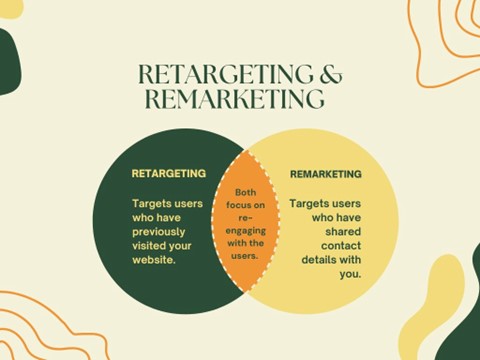Retargeting vs Remarketing: Which is better?
This blog illustrates the meaning of remarketing and retargeting. Remarketing vs retargeting, read to know what is best for your business.

As the digital realm continues to undergo rapid evolution, engaging and retaining customers presents a formidable challenge. Fortunately, astute marketers have at their disposal two potent weapons: remarketing and retargeting. The conundrum, however, lies in determining which of these two techniques reigns supreme and which takes on the role of loyal sidekick.
Remarketing and retargeting are two of the most popular marketing strategies businesses use today. Both these strategies are designed to help enterprises re-engage with potential customers who have previously shown interest in their products or services. However, while they share a common goal, remarketing and retargeting are not the same thing. This blog highlights the differences between the two strategies and explores which is better: Remarketing or Retargeting.

What is Retargeting?
Retargeting is a form of digital advertising that targets users who have formerly visited a website or engaged with a brand in some way. When a user visits a website, a cookie is placed on their browser, tracking their behavior. This information can then be used to show the user targeted ads across the web, encouraging them to return to the site and complete a purchase.
Retargeting campaigns can be set up in several ways. One popular method is to display a specific ad to users who have abandoned their shopping cart. For example, suppose a user adds an item to their cart but does not complete the purchase. In that case, a retargeting ad may be displayed on other sites the user visits, reminding them of the item they left behind and encouraging them to return and complete the purchase.
Another familiar use case for retargeting is to target users who have visited a specific page on a website. For example, a travel company may use retargeting to show ads to users who have visited a page about a particular destination, promoting deals and discounts related to that location.
Retargeting can be an effective way to re-engage with users who have shown interest in a product or service. By displaying targeted ads to these users, businesses can encourage them to return to the site and complete a purchase. However, retargeting has some limitations. For example, it can be difficult to target users who have visited your site but have yet to take any specific action, such as filling out a form or adding an item to their cart.
What is Remarketing?
Remarketing is similar to retargeting in a way that it targets users who have previously interacted with a brand. However, unlike retargeting, which focuses on online advertising, remarketing can involve a variety of channels, including email, SMS, and direct mail.
Remarketing campaigns are typically set up to target users who have provided their contact information, such as an email address or phone number. These users may have signed up for a newsletter, downloaded a whitepaper, or attended a webinar. Once a user has provided their contact information, the business can use this information to send targeted messages to the user, encouraging them to take a specific action.
For example, a business may use remarketing to send a targeted email to users who have downloaded a whitepaper, inviting them to sign up for a free trial of their product. Alternatively, a business may use remarketing to send a direct mail piece to users who have attended a webinar, offering a discount on their services.
Remarketing can be a highly effective way to re-engage with users interested in a brand. By targeting users through various channels, businesses can increase the likelihood of a user taking a specific action, such as signing up for a trial or making a purchase. However, remarketing also has some limitations. For example, targeting users still need to provide their contact information can be difficult.
Remarketing vs. Retargeting: Which is Better?
Both remarketing and retargeting have their own strengths and weaknesses, and which strategy is better for your business will depend on your specific marketing goals and target audience.
Retargeting is generally more effective at targeting users who have already shown a high level of intent. For example, suppose a user has added an item to their cart but has not completed the purchase. In that case, retargeting can encourage them to return and complete the purchase. Similarly, suppose a user has visited a specific page on a website. In that case, retargeting can show targeted ads related to that page, encouraging them to learn more about the product or service offered.
Remarketing, conversely, is generally more effective at targeting users who have not yet taken a specific action but have shown interest in a brand. For example, suppose a user has downloaded a whitepaper or attended a webinar. In that case, remarketing can be used to send targeted messages to the user with personalized CTAs, such as signing up for a free trial or making a purchase.
Conclusion
Reaching out to the right audience is crucial because it ensures that your message is being conveyed to the people most likely to be interested in what you offer. By identifying and targeting the right audience, you can maximize your marketing efforts’ effectiveness, minimize resource wastage, and improve your overall return on investment. Additionally, reaching out to the right audience can be beneficial as it can lead to a lack of engagement, low conversion rates, and damage to your brand’s reputation. Both remarketing and retargeting can be highly effective marketing strategies when used correctly.
Businesses can use both approaches to create a powerful marketing campaign targeting users at every marketing funnel stage. The key is understanding your target audience and tailoring your marketing efforts accordingly. Essentially, the question is not about remarketing or retargeting. The more prudent thing to consider here is remarketing & retargeting, an approach that imbibes the best of both. But remarketing or retargeting, whatever be your choice, it is essential that the right content is delivered to the right people at the right time, in the place, and with the right content.



